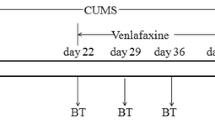Abstract
Objective
To determine the mechanisms underlying the anti-depressant effects of Kaixin Jieyu Decoction (开心解郁汤, KJD) by investigating the effects of KJD on behavior, monoamine neurotransmitter levels, and serotonin (5-HT) receptor subtype expression in the brain in a rat model of depression.
Methods
The rat depression model was established using chronic unpredictable mild stress (CUMS). Forty-eight Sprague Dawley rats were randomly divided into control, depression model (CUMS), CUMS+KJD (7.7 g/kg−1·d−1 of crude drug), and CUMS+fluoxetine (2.4 mg/kg−1·d−1) groups (n=12 in each group), and the treatments lasted for 21 days. We regularly evaluated body weight, sucrose consumption, and horizontal and vertical activity scores in open-field tests. The content of the monoamine neurotransmitters 5-HT, norepinephrine (NE), and dopamine (DA) and the DA metabolite homovanillic acid in the cerebral cortex, and 5-HT1A and 5-HT2A receptor mRNA in the cerebral cortex and the hippocampus, were determined respectively by high-performance liquid chromatography-coularray electrochemical detector and real-time polymerase chain reaction.
Results
Compared with the control group, CUMS rats showed a variety of depression-like behavioral changes, including a significant reduction in body weight, sucrose consumption, and horizontal and vertical activity scores in open-field tests (P<0.05 or P<0.01), and a significant decrease in 5-HT and NE levels and 5-HT2A receptor mRNA expression. In contrast, they showed a significant increase in 5-HT1A receptor mRNA expression in the cerebral cortex. In the hippocampus, 5-HT1A receptor mRNA expression was lower whereas 5-HT2A receptor mRNA expression was higher than in the control group (P<0.05 or P<0.01). Treatment with KJD or fluoxetine partially attenuated these changes (P<0.05 or P<0.01).
Conclusion
KJD could normalize the levels of 5-HT and NE and adjust the balance of 5-HT1A and 5-HT2A receptor expression in rat cerebrum, and this may be one of mechanisms of antidepressant effects of KJD.
Similar content being viewed by others
References
Berton O, Nestle EJ. New approaches to antidepressant drug discovery: beyond monoamines. Nat Rev Neurosci 2006;7:137–151.
Huang SJ, Wu W, Fang SF. Discussion on vital qi-tonifying and stasis-eliminating therapy on vascular depression. Chin J Inf Traidit Chin Med (Chin) 2009;16:85–86.
Lin YH, Liu AH, Xu Y, Tie L, Yu HM, Li XJ. Effect of chronic unpredictable mild stress on brain-pancreas: relative protein in rat brain and pancreas. Behav Brain Res 2005;165:63–71.
Willner P. Validity, reliability and utility of the chronic mild stress model of depression: a 10-year review and evaluation. Psychopharmacology (Berl) 1997;134:319–329.
Wang SS, Yan XB, Hofman MA, Swaab DF, Zhou JN. Increased expression level of corticotropin-releasing hormone in the amygdala and in the hypothalamus in rats exposed to chronic unpredictable mild stress. Neurosci Bull 2010;26:297–303.
van Praag HM. Can stress cause depression? Prog Neuropsychopharmacol Biol Psychiatry 2004;28:891–907.
Willner P. Chronic mild stress (CMS) revisited: consistency and behavioural-neurobiological concordance in the effects of CMS. J Neuropsychobiol 2005;52:90–110.
Belmaker RH, Agam G. Major depressive disorder. N Engl J Med 2008;358:55–68.
Páez-Pereda M. New drug targets in the signaling pathways activated by antidepressants. Pro Neuropsychopharmacol Biol Psychiatry 2005;29:1010–1016.
Green AR. Neuropharmacology of 5-hydroxytryptamine. Br J Pharmacol 2006;147:S145–S152.
Filip M, Bader M. Overview on 5-HT receptors and their role in physiology and pathology of the central nervous system. Pharmacol Rep 2009;61:761–777.
Alexandre C, Popa D, Fabre V, Bouali S, Venault P, Lesch KP, et al. Early life blockade of 5-hydroxytryptamine 1A receptors normalizes sleep and depression-like behavior in adult knock-out mice lacking the serotonin transporter. J Neurosci 2006;26:5554.
Santarelli L, Saxe M, Gross C, Surget A, Battaglia F, Dulawa S, et al. Requirement of hippocampal neurogenesis for the behavioral effects of antidepressants. Science 2003;301:805–809.
Carli M, Baviera M, Invernizzi RW, Balducci C. Dissociable contribution of 5-HT1A and 5-HT2A receptors in the medial prefrontal cortex to different aspects of executive control such as impulsivity and compulsive perseveration in rats. Neuropsychopharmacology 2006;31:757–767.
Blier P, Ward N M. Is there a role for 5-HT1A agonists in the treatment of depression? Biol Psychiatry 2003;53:193–203.
Katz MM, Tekell JL, Bowden CL, Brannan S, Houston JP, Berman N, et al. Onset and early behavioral effects of pharmacologically different anti-depressants and placebo in depression. Neuropsychopharmacology 2004;29:566–579.
Thase ME, Entsuah AR, Rudolph RL. Remission rates during treatment with venlafaxine or selective serotonin reuptake inhibitors. Br J Psychiatry 2001;178:234–241.
Mathew SJ, Manji HK, Charney DS. Novel drugs and therapeutic targets for severe mood disorders. Neuropsychopharmacology 2008;33:2080–2092.
Marek GJ, Martin-Ruiz R, Abo A, Artigas F. The selective 5-HT2A receptor antagonist M100907 enhances antidepressant-like behavioral effects of the SSRI fluoxetine. Neuropsychopharmacology 2005;30:2205–2215.
Szabo ST, Blier P. Effects of serotonin (5-hydroxytryptamine, 5-HT) reuptake inhibition plus 5-HT2A receptor antagonism on the firing activity of norepinephrine neurons. J Pharmacol Exp Ther 2002;302:983–991.
Author information
Authors and Affiliations
Corresponding author
Additional information
Supported by the National Natural Science Foundation of China (No. 30672696 and 81072801)
Rights and permissions
About this article
Cite this article
Huang, Sj., Zhang, Xh., Wang, Yy. et al. Effects of Kaixin Jieyu Decoction (开心解郁汤) on behavior, monoamine neurotransmitter levels, and serotonin receptor subtype expression in the brain of a rat depression model. Chin. J. Integr. Med. 20, 280–285 (2014). https://doi.org/10.1007/s11655-014-1343-0
Received:
Published:
Issue Date:
DOI: https://doi.org/10.1007/s11655-014-1343-0



